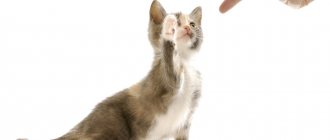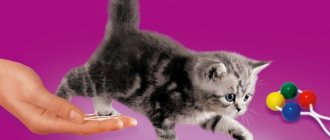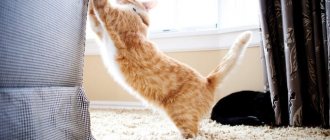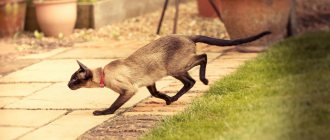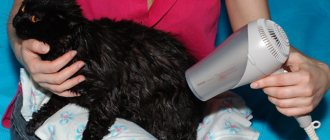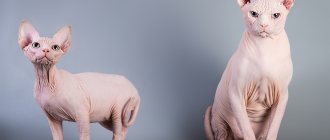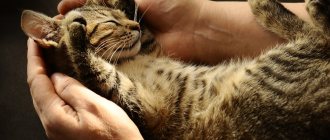Another common reason for visiting a veterinarian regarding a tail is a stiff tail. Owners complain that the Scottish kitten’s stiff tail does not bend, as if it consists of one bone. In this case, the joints can be felt, but this does not affect mobility in any way.
The situation often develops as follows. First, mineral metabolism is disrupted, as a result, the vertebrae do not receive enough of the necessary elements and become thinner, and the cartilage, on the contrary, grows. As a result, the tail becomes like a rosary. Further, the cartilage tissue can become denser, and the joint lubrication loses its quality: clicks can be heard when the tail flaps. This is an alarming signal that requires a comprehensive solution. If treatment is not started on time, the processes continue - as a result, what we call a hard, rigid tail appears.
This problem is typical for fold-eared cats, for which they have their marks reduced at shows and disqualified, because... the lop-eared gene, if both parents are lop-eared, in the offspring leads not only to a stiff tail, but also to disruption of the formation of the skeletal system as a whole, including osteochondrosis and osteochondrodysplasia.
Why are cats tailless?
Geneticists couldn't ignore tailless cats
and conducted research on the biological nature of species and developed their theory about their origin.
Cats with short tails were the result of natural selection, the influence of a mutated gene that passed from cat to cat in each generation.
Today there are several varieties of breeds without a tail. Some do not have it at all, while others have several vertebral segments that look like a fluffy pom-pom.
Buy Mekong Bobtail
The Mekong is widespread both in Europe and in Russia and the CIS countries. There are many professional Thai Bobtail kennels. Buying a purebred pet-, breed- or show-class pet for yourself will not be difficult.
In addition to specialized nurseries, Mekong cats are actively sold on various message boards (for example, Avito and Yula). However, remember that a transaction with a private person always has more risks than with an official representative.
Caring for bobtail cats
Care consists of preserving the beauty of the fur coat, its cleanliness and preventive care for the eyes, ears and claws.
Once every 14 days, cats of the tailless cat breed need to be washed using special cat shampoos. Usually, short-tailed animals do not protest against water procedures, especially if they have been accustomed to them since childhood. The Kurilian Bobtail considers it a pleasure to take another swim, and besides, getting its fur wet is quite difficult.
Once a week, caring owners comb out their pets' hair. They are accustomed to the procedure from the moment the kitten enters the house. The fur coat should be given special attention during molting.
Also, cats have their nails trimmed once a month - this is an important and mandatory procedure for the pet’s health.
A visit to the veterinarian will not be superfluous - he will draw up a schedule of vaccinations, monitor the health of the pet and give advice on care and maintenance.
Keeping tailless cats
global $ads_google;
//data-ad-slot=”2475549904″ $ads_google = empty($ads_google) ? false : true; ?> if ($ads_google == false) {?> $ads_google = true; ?> } ?> A dog in a cat – two in one. This is how to describe cat breeds without a tail
. Keeping such a cat-dog in the house is very interesting.
Keeping a cat without a tail is not difficult, however, you must constantly remember the similarity of the character of a cat and a dog - the animal will again and again demand attention from its owner.
This thirst for attention can be turned to the benefit of the family if there is a small child in the house who will plunge not only into games, but also into caring for the cat.
Since cats without a tail do not want to mark their territory, keeping them is much easier.
Such fluffy creatures love to walk, and will not be upset at all if the owner walks them on a leash or harness.
Feeding
Breeds of tailless cats are demanding about the quality of food. If you decide to feed your pet commercial dry food, it must also be of high quality.
Both an experienced breeder and a veterinarian can help in choosing the right diet. It is very important to create a suitable balanced diet. If the cat is pregnant or sick, then significant adjustments are made to the menu. Therefore, it is worth remembering that having a cat with a pom-pom tail makes the veterinarian the best adviser.
When a cat reaches adulthood, it is best for him to choose a menu that will be the main one throughout his life.
In the spring-autumn period, cats are fed with vitamin complexes.
Feeding is carried out twice a day, with the last time food is given at six o'clock in the evening.
History of the Mekong Botail breed
The Thai Bobtail is a very ancient breed that evolved naturally. For a long time, Thai beans lived only in Asia. They were common in India, Siam, China, Burma, Iran, Iraq and Vietnam.
Siamese short-tailed cats originated from ordinary Siamese cats. The Mekongs were highly valued by Asians, they were kept at temples, and legends were made about them. Local residents did not allow visitors to export animals abroad; they considered them their national treasure.
One of the earliest mentions of the Mekong dates back to 1883. Charles Darwin in his book described Thais as Siamese cats with a short tail.
At the beginning of the 19th century, King Ram V of Siam gave several Siamese bobtails to Russian Tsar Nicholas II as a sign of respect. Years later, in 1867, English governess Anne Crawfold was working for the royal family in Siam. Upon returning home, she managed to bring home two tailless Siamese kittens. A few years later, the Siamese gave several cats to the British Ambassador Owen Gould.
It was during these years that Mekong bobtails began to rapidly conquer Europe. In 1890, Thai cats came to the United States. Animals were brought to the CIS countries and Russia a little later - at the very beginning of the last century.
The Mekong Bobtail breed is natural, having evolved without human influence. Experts believe that the curly short tail is the result of a genetic failure. The mutation most likely occurred due to repeated crossings of related Siamese cats (that is, brother with sister, descendants with parents, etc.).
Character of cats without a tail
global $ads_google;
//data-ad-slot=”2475549904″ $ads_google = empty($ads_google) ? false : true; ?> if ($ads_google == false) {?> $ads_google = true; ?> } ?> For some reason, a cat with a short tail, or with its complete absence, surprises people who meet such individuals for the first time. But these animals do well without this part of the body, which is so necessary for other breeds to maintain balance in their movements. But this gift of nature allowed the tailless animals to develop excellent muscles and an amazing sense of balance.
The character of pom-pom pussies is delightful: a family friend, a protective friend, a playmate. There is no need to fear for other pets if you decide to get a tailless one - it will find a common language with every animal in the house.
The owner's attention will always be met with a satisfied “mur-mur” in response.
Separately, it is worth saying that tailless cats
They have a high level of intelligence, which is also very popular with their owners.
General description of the Kuril Bobtail breed
Kurilian Bobtail
cat can be called a “lynx in miniature.” Approximately the same body structure, the same smooth movements, a short stubby tail, a characteristic pockmarked coat color - all this is a smaller copy of a wild predator.
The Kurilian Bobtail has:
- muscular and compact body of medium size,
- smooth curves of the body,
- the head is shaped like an equilateral triangle with roundings,
- the forehead smoothly transitions to a straight nose,
- low cheekbones,
- full cheeks,
- strong chin.
Body structure:
The hind legs of bobtails are noticeably longer than the front ones.
The body of the animal is strong, but not rough, slightly elongated. The limbs are of medium length, the paws are round, the tail is very short, shaped like a “pompom”. The length of the tail is no more than 10-12 cm. It is well pubescent, composed of 2-12 diversified vertebrae and can be characterized by varying mobility.
A distinctive feature of the Kuril Bobtail, in addition to the practically absence of a tail, is the structure of the paws. The hind legs are slightly longer than the front legs, which is why cats of this breed are always slightly tilted downwards.
Another feature is that the claws do not retract into the pads, so when bobtails walk on the floor, a slight clicking sound is heard, like from a small dog.
In addition, they have an agile gait
like a wild cat stalking its prey.
Head structure:
The ears are set high and wide, rounded at the ends and have characteristic brushes.
The Kurilian Bobtail's eyes are slightly slanted, medium in size and almond-shaped, not protruding or deep. According to standards approved in 1995, the color of a cat's eyes must correspond to a certain color. Any shade of yellow-green eye color is acceptable.
Weight and body size of Kurilian Bobtails
Active growth of Kurilian Bobtails usually ends when the kitten is 6-7 months old. Thus, already at 7 months you can understand how large your cat will be. The body size is standard; there are no exact parameters for what a cat of this breed should be.
Average weight
adult Kurilian bobtails: males - 4-6 kg, females - 3-4 kg. But there are also heavyweights: cats can weigh up to 5.5 kg, males - up to 9.5 kg.
How long do Kurilian Bobtails live?
The life expectancy of Kurilian Bobtails is different compared to cats of other breeds. On average, bobtails live 15-20 years.
What does a cat's tail tell you?
Some have just one, while others have a whole pride. For example, Susan Naffer, chairman of the Morris Animal Foundation of California and also an amateur cat breeder, has 11 of them, and she is unlikely to hold the record for this number.
It turns out that Australia has the most of them: there are nine pussies for every ten inhabitants. Indonesia is the leader in Asia - there are more than 30 million cats in this country. In Europe - France with eight million. But, for example, in Peru and Gabon there are almost none.
Photo: pixabay.com
Cats communicate with their owners in many ways, and the tail is especially important in a cat's behavior because it is not only a means of balance. So let's talk about it.
If it is lowered, it means that the pussy may be tired. If it's slightly tucked under the belly, she's disappointed. But when the tail is raised up, it is a sign of complete satisfaction. If at the same time the tip also moves smoothly, then this means that you are welcome. Carl van Vechten, in his book A Tiger in the House, notes that a cat's tail held high also signifies pride. A cat walking with its tail held high demonstrates its dominance in the area.
Complete satisfaction! Photo: pixabay.com
When a cat approaches you with a slightly quivering tail, this is how it expresses the greatest feeling of love. But if he twitches nervously, he gets angry. Interest in something is expressed by a slight wiggle of the tail. Cats, like people, have to make a choice from time to time - in this case, they will start wagging their tail until they make a decision. Funny, right?
During the hunt, they put it back and express distrust by sharply bending their tail. If the tail moves in a circular motion while the ears are pressed to the head, this is a sign of obvious irritation.
A sharp bend in the tail is a clear sign of distrust Photo: pixabay.com
And if kittens run up to their mother with their tails raised and begin to rub their sides against her, then adult cats behave this way towards their owner or mistress: they rub their tails against their legs in anticipation of food or affection.
When threatened with attack, the hairs on the cat's tail stand up and bristle. By the way, domestic cats, unlike wild cats, can move with their tail raised vertically.
Photo: pixabay.com
But how do tailless cats cope without such an important organ? For example, the breed that lives on the Isle of Man, or those that have lost their tail due to injury? Somehow they get by. However, according to veterinarians (particularly Dr. Michael Fox), “their signaling repertoire has been greatly reduced. It is as if a person communicating in sign language had no fingers! This is a drawback. An essential element of communication is lost.”
Of course, cats communicate with each other and with people not only with the help of their tail: they also have a voice, ears, and paws. But the tail is extremely important for communication, especially in purrs, which are silent by nature, and it is useful for owners to know this animal language. Is not it?
Tags: cat tail, domestic cat, animal language, cat behavior
Myths and truth about Kuril Bobtails
1. Kurilian bobtails are cats without a tail.
Yes, they are often called that. BUT! All Kurilian Bobtails have small tails. Moreover, you will not find bobtails with absolutely identical tails.
2. Kurilian bobtails have their tails docked.
It is not true! Kittens are born with short tails.
3. Bobtails do not shed.
This is not true. Like any cat, Kurilian Bobtails shed.
4. Kurilian bobtails do not mark territory.
Unfortunately, this is also a myth. If the cat is not neutered, then the bobtail, like any other cat, will act out.
5. Bobtails do not damage furniture with their claws.
Yes it is. Short-tailed cats are well-mannered cats.
6. Kurilian Bobtails love to travel and walk on a leash.
And it is true. Bobtails are easier than other cats to learn to use a leash. This is one of the most comfortable cat breeds for traveling.
Dragon Li
At first glance, this breed is no different from ordinary domestic cats, but the distinctive feature of the Li Mao breed is green or yellow slightly slanted almond-shaped eyes, and small black dots (in the form of a smile) at the edges of the mouth. And also a strong, muscular body, proportional paws of equal length, an elongated head with a rounded forehead, rounded ears and, of course, a long tail. Brown tabby is the only color recognized for this breed.
Dragons are smart cats with a calm character . Because of this, they are easy to train and learn. They get along easily with other pets, but have a hard time getting used to children (although they treat them with due tolerance). Li dragons do not require special care and do not have hereditary diseases.
Kurilian bobtail wool
This type of cat breed is distinguished by the fact that its representatives can be both short-haired and semi-long-haired.
.
Short-haired Kuril Bobtails should have a thin and small coat with a thick undercoat. The hair is longer on the lower part of the body and at the back.
Semi-longhair cats have long and fine hair and they also have a clearly visible and dense undercoat. There is a “collar” on the animal’s neck and chest.
Kurilian bobtail color
can be absolutely anything: red or gold, black, white (except for color point and Abyssinian).
The most standard colors are tabby (the color of a cheetah, leopard) and bicolor (the ratio of white to other colors).
“Tiger” stripes on a cat’s body are another color option: there are vertical lines on the sides of the animal, and a dark stripe stretches along the tail and back.
Also, there is a marbled color, when there are characteristic stains on the sides of the bobtail, and two lines run along the back.
Bobtails love to talk using different intonations and sounds.
The uniqueness of bobtail wool
is that it practically does not get wet. Water flows off it in small drops, like from a goose. Their fur rarely gets dirty, does not stick together, and does not form tangles.
How to distinguish by character
Siberian cats differ from other breeds not only in appearance, but also in their serious, independent character. A person who decides to get a “Siberian” needs to know that representatives of the breed:
- friendly, but without intrusiveness;
- delicate, not inclined to pester a busy owner;
- are independent, find something to do, do not need constant human attention;
- aristocratic, have self-esteem, do not allow themselves to be squeezed;
- they are polite with strangers, but keep their distance;
- they choose one owner, and treat the rest of the family with moderate friendliness;
- They are indifferent to children, they try to ignore their pestering, but if the child behaves arrogantly and mocks them, they can fight back.
Interesting! “Siberians” have a pronounced hunting instinct. Large cats can attack not only rodents and birds, but also small dogs, and if the owner is in danger, they boldly protect him.

